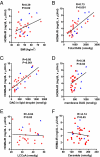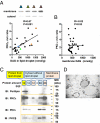Cellular mechanism of insulin resistance in nonalcoholic fatty liver disease
- PMID: 21930939
- PMCID: PMC3182681
- DOI: 10.1073/pnas.1113359108
Cellular mechanism of insulin resistance in nonalcoholic fatty liver disease
Abstract
Insulin resistance is associated with nonalcoholic fatty liver disease (NAFLD) and is a major factor in the pathogenesis of type 2 diabetes. The development of hepatic insulin resistance has been ascribed to multiple causes, including inflammation, endoplasmic reticulum (ER) stress, and accumulation of hepatocellular lipids in animal models of NAFLD. However, it is unknown whether these same cellular mechanisms link insulin resistance to hepatic steatosis in humans. To examine the cellular mechanisms that link hepatic steatosis to insulin resistance, we comprehensively assessed each of these pathways by using flash-frozen liver biopsies obtained from 37 obese, nondiabetic individuals and correlating key hepatic and plasma markers of inflammation, ER stress, and lipids with the homeostatic model assessment of insulin resistance index. We found that hepatic diacylglycerol (DAG) content in cytoplasmic lipid droplets was the best predictor of insulin resistance (R = 0.80, P < 0.001), and it was responsible for 64% of the variability in insulin sensitivity. Hepatic DAG content was also strongly correlated with activation of hepatic PKCε (R = 0.67, P < 0.001), which impairs insulin signaling. In contrast, there was no significant association between insulin resistance and other putative lipid metabolites or plasma or hepatic markers of inflammation. ER stress markers were only partly correlated with insulin resistance. In conclusion, these data show that hepatic DAG content in lipid droplets is the best predictor of insulin resistance in humans, and they support the hypothesis that NAFLD-associated hepatic insulin resistance is caused by an increase in hepatic DAG content, which results in activation of PKCε.
Conflict of interest statement
The authors declare no conflict of interest.
Figures



Similar articles
-
CGI-58 knockdown sequesters diacylglycerols in lipid droplets/ER-preventing diacylglycerol-mediated hepatic insulin resistance.Proc Natl Acad Sci U S A. 2013 Jan 29;110(5):1869-74. doi: 10.1073/pnas.1219456110. Epub 2013 Jan 9. Proc Natl Acad Sci U S A. 2013. PMID: 23302688 Free PMC article.
-
Hepatic Diacylglycerol-Associated Protein Kinase Cε Translocation Links Hepatic Steatosis to Hepatic Insulin Resistance in Humans.Cell Rep. 2017 Jun 6;19(10):1997-2004. doi: 10.1016/j.celrep.2017.05.035. Cell Rep. 2017. PMID: 28591572 Free PMC article.
-
Nonalcoholic fatty liver disease, hepatic insulin resistance, and type 2 diabetes.Hepatology. 2014 Feb;59(2):713-23. doi: 10.1002/hep.26672. Hepatology. 2014. PMID: 23929732 Free PMC article. Review.
-
Diacylglycerol activation of protein kinase Cε and hepatic insulin resistance.Cell Metab. 2012 May 2;15(5):574-84. doi: 10.1016/j.cmet.2012.03.005. Cell Metab. 2012. PMID: 22560210 Free PMC article. Review.
-
Hepatic insulin resistance in mice with hepatic overexpression of diacylglycerol acyltransferase 2.Proc Natl Acad Sci U S A. 2011 Apr 5;108(14):5748-52. doi: 10.1073/pnas.1103451108. Epub 2011 Mar 21. Proc Natl Acad Sci U S A. 2011. PMID: 21436037 Free PMC article.
Cited by
-
High-fat-diet-induced hepatic insulin resistance per se attenuates murine de novo lipogenesis.iScience. 2024 Oct 15;27(11):111175. doi: 10.1016/j.isci.2024.111175. eCollection 2024 Nov 15. iScience. 2024. PMID: 39524330 Free PMC article.
-
No Difference in Liver Damage Induced by Isocaloric Fructose or Glucose in Mice with a High-Fat Diet.Nutrients. 2024 Oct 21;16(20):3571. doi: 10.3390/nu16203571. Nutrients. 2024. PMID: 39458565 Free PMC article.
-
Appendicular skeletal muscle mass is associated with metabolic dysfunction-associated steatotic liver disease severity in young men: a cross-sectional and longitudinal study.Hepatol Int. 2024 Oct 12. doi: 10.1007/s12072-024-10737-8. Online ahead of print. Hepatol Int. 2024. PMID: 39394385
-
Nonalcoholic Fatty Liver Disease and Staging of Hepatic Fibrosis.Adv Exp Med Biol. 2024;1460:539-574. doi: 10.1007/978-3-031-63657-8_18. Adv Exp Med Biol. 2024. PMID: 39287864 Review.
-
Intestinal Nogo-B reduces GLP1 levels by binding to proglucagon on the endoplasmic reticulum to inhibit PCSK1 cleavage.Nat Commun. 2024 Aug 10;15(1):6845. doi: 10.1038/s41467-024-51352-3. Nat Commun. 2024. PMID: 39122737 Free PMC article.
References
-
- Grundy SM. Metabolic syndrome pandemic. Arterioscler Thromb Vasc Biol. 2008;28:629–636. - PubMed
-
- Wild S, Roglic G, Green A, Sicree R, King H. Global prevalence of diabetes: Estimates for the year 2000 and projections for 2030. Diabetes Care. 2004;27:1047–1053. - PubMed
-
- Cheung O, Sanyal AJ. Recent advances in nonalcoholic fatty liver disease. Curr Opin Gastroenterol. 2010;26:202–208. - PubMed
-
- Savage DB, Semple RK. Recent insights into fatty liver, metabolic dyslipidaemia and their links to insulin resistance. Curr Opin Lipidol. 2010;21:329–336. - PubMed
Publication types
MeSH terms
Substances
Grants and funding
LinkOut - more resources
Full Text Sources
Other Literature Sources


